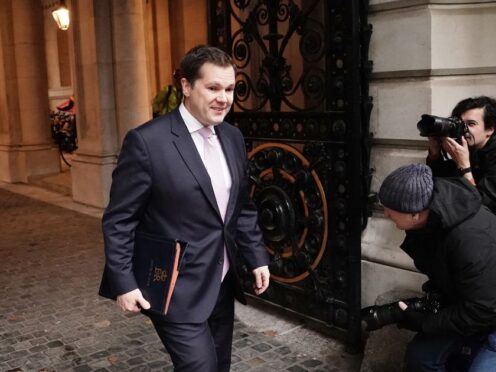
The Government must “undo the disastrous post-Brexit liberalisations” that “betrayed” the public’s wish for lower immigration before the general election, Robert Jenrick has demanded.
The Tory former immigration minister has put forward more than 30 recommendations to curb migration in a Centre for Policy Studies (CPS) report he co-authored.
The proposals include capping health and care visas at 30,000, scrapping the graduate route for international students, and indexing salary thresholds for visa routes in line with inflation.
The Home Office should be broken up to create a department more focused on border control, the report for the centre-right think tank also says.
It argues that net migration needs to be wound back to “the tens of thousands”.
Mr Jenrick, who is seen as a potential Tory leadership contender, has been ramping up pressure on Rishi Sunak over immigration.
He and fellow MPs on the Conservative right have been urging the Prime Minister to take action since revised official estimates published in November indicated the net migration figure – the difference between the number of people arriving and leaving Britain – reached a record 745,000 in 2022.
Mr Sunak has faced demands for a change of political course as MPs from both sides of the Tories hope to reverse its electoral fortunes in the wake of a drubbing in local and regional contests.
The British public are still waiting for the highly-selective post-Brexit immigration system they were promised.
Tomorrow my report with @NeilDotObrien and @CPSThinkTank sets out how to deliver it.
My @Telegraph column on why inaction is unforgivable ⬇️https://t.co/E0mucLnOf1
— Robert Jenrick (@RobertJenrick) May 7, 2024
Mr Jenrick and his co-authors, Tory former minister Neil O’Brien and CPS research director Karl Williams, argue that large-scale migration has failed to deliver significant fiscal benefits while putting pressure on housing, public services and infrastructure.
Mr Jenrick said: “It would be unforgivable if the Government did not use the time before the general election to undo the disastrous post-Brexit liberalisations that betrayed the express wishes of the British public for lower immigration.
“The changes we propose today would finally return numbers to the historical norm and deliver the highly-selective, highly-skilled immigration system voters were promised. These policies could be implemented immediately and would consign low-skilled mass migration to the past.
“Immigration is consistently one of the top concerns of voters and they deserve a department whose sole mission is controlling immigration and securing our borders. For far too long, the Home Office has proven incapable of doing that.”
The Conservative MP for Newark resigned as immigration minister in December in protest at Mr Sunak’s Rwanda deportation plan, arguing it would not act as a strong enough deterrent to stop asylum seekers arriving via small boats.
The Government is introducing a raft of restrictions in a bid to cut the number of people legally arriving in Britain, including a ban on overseas care workers bringing family dependants to the UK and a drastically hiked salary threshold for skilled workers to £38,700.
A Government spokesperson said: “The Prime Minister and Home Secretary have been clear that current levels of migration are far too high. That is why the Government announced a plan to cut the number of migrants that would have come last year to the UK by 300,000 – the largest reduction ever.
“This plan is working, with the latest statistics showing applications across three major visa categories are down by 24%.
“Our approach is fair – reducing immigration and ensuring businesses invest in and recruit from the domestic workforce, whilst prioritising the overseas workers and students who will contribute significantly to our economy.”

Enjoy the convenience of having The Sunday Post delivered as a digital ePaper straight to your smartphone, tablet or computer.
Subscribe for only £5.49 a month and enjoy all the benefits of the printed paper as a digital replica.
Subscribe